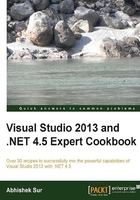
Conventions
In this book, you will find a number of styles of text that distinguish between different kinds of information. Here are some examples of these styles, and an explanation of their meaning.
Code words in text, database table names, folder names, filenames, file extensions, pathnames, dummy URLs, user input, and Twitter handles are shown as follows: "The program will pause during the first Run method."
A block of code is set as follows:
static void Main()
{
Thread.CurrentThread.Name = "Main Thread";
Thread t1 = new Thread(new ThreadStart(Run));
t1.Name = "Thread 1";
Thread t2 = new Thread(new ThreadStart(Run));
t2.Name = "Thread 2";
t1.Start();
t2.Start();
Run();
}
static void Run()
{
Console.WriteLine("hello {0}!", Thread.CurrentThread.Name);
Thread.Sleep(1000);
}
When we wish to draw your attention to a particular part of a code block, the relevant lines or items are set in bold:
// Type 'Abhishek' in 'txtInput' text box
uITxtInputEdit.Text = this.ReverseStringTestParams.UITxtInputEditText;
Any command-line input or output is written as follows:
ALTER DATABASE MyDatabase MODIFY (EDITION='BUSINESS', MAXSIZE=100GB)
New terms and important words are shown in bold. Words that you see on the screen, in menus or dialog boxes for example, appear in the text like this: "You can declare a local variable using the Watch window and use it in the conditions."
Note
Warnings or important notes appear in a box like this.
Tip
Tips and tricks appear like this.